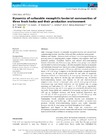Dynamics of culturable mesophilic bacterial communities of three fresh herbs and their production environment
dc.contributor.author
Gekenidis, Maria-Theresia
dc.contributor.author
Gossin, Diane
dc.contributor.author
Schmelcher, Mathias
dc.contributor.author
Schöner, Ulrich
dc.contributor.author
Remus-Emsermann, Mitja N.P.
dc.contributor.author
Drissner, David
dc.date.accessioned
2017-10-13T12:45:56Z
dc.date.available
2017-10-06T02:44:54Z
dc.date.available
2017-10-13T12:45:56Z
dc.date.issued
2017-10
dc.identifier.issn
1364-5072
dc.identifier.issn
1365-2672
dc.identifier.other
10.1111/jam.13532
en_US
dc.identifier.uri
http://hdl.handle.net/20.500.11850/191012
dc.identifier.doi
10.3929/ethz-b-000191012
dc.description.abstract
Aim
Investigate dynamics of culturable mesophilic bacteria and selected food-contaminating bacteria from three herbs and their production environment.
Methods and Results
Marjoram, basil and thyme were investigated during one growing season by sampling plants, organic fertilizers, soil, irrigation water and marketed products. Mesophilic bacteria and selected food-contaminating bacteria (Escherichia coli, Enterococcus spp., Bacillus cereus group) were cultured and identified by MALDI biotyping. Culturable mesophilic bacteria on marjoram and basil plants decreased over time by two orders of magnitude starting at above 106 colony forming units per gram (CFU per g), while they remained constant on thyme (~104 CFU per g). Compared to the last field sample, mesophilic bacteria were increased on all market-ready products by one order of magnitude. Marjoram and basil were dominated by B. cereus group, Enterobacter spp. and Pseudomonas spp., thyme by Bacillus spp. and Pseudomonas spp. All selected food-contaminating bacteria were detected in soil and reservoir-sourced irrigation water, whereas in municipal water, only B. cereus group and rarely Enterococcus spp. were found. Escherichia coli was detected only on young marjoram and basil plants (5 × 102 and 5 × 101 CFU per g, respectively), whereas Enterococcus spp. and B. cereus group were consistently detected on these two herbs. Thyme plants only contained B. cereus group consistently (above 103 CFU per g). Marketed marjoram and thyme contained Enterococcus spp. (5 × 102 and 104 CFU per g) and B. cereus group (~5 × 102 CFU per g), while no selected food-contaminating bacteria were found on marketed basil.
Conclusions
Overall, culturable mesophilic bacteria were dominated by Pseudomonas spp. and Bacillus spp., with increased numbers on market-ready products. Selected food-contaminating bacteria were readily detectable, however, only the B. cereus group was found throughout in all systems.
Significance and Impact of the Study
Insight into composition and development of mesophilic bacterial communities and selected food-contaminating bacteria of fresh herbs contributes to estimating consumer exposure.
en_US
dc.format
application/pdf
dc.language.iso
en
en_US
dc.publisher
Wiley-Blackwell
en_US
dc.rights.uri
http://creativecommons.org/licenses/by/4.0/
dc.subject
Agriculture
en_US
dc.subject
Food
en_US
dc.subject
microbial contamination
en_US
dc.subject
Soil
en_US
dc.subject
Water
en_US
dc.title
Dynamics of culturable mesophilic bacterial communities of three fresh herbs and their production environment
en_US
dc.type
Journal Article
dc.rights.license
Creative Commons Attribution 4.0 International
dc.date.published
2017-08-25
ethz.journal.title
Journal of Applied Microbiology
ethz.journal.volume
123
en_US
ethz.journal.issue
4
en_US
ethz.journal.abbreviated
J. appl. microbiol. (Print)
ethz.pages.start
916
en_US
ethz.pages.end
932
en_US
ethz.version.deposit
publishedVersion
en_US
ethz.identifier.wos
ethz.identifier.scopus
ethz.publication.place
Oxford
en_US
ethz.publication.status
published
en_US
ethz.leitzahl
ETH Zürich::00002 - ETH Zürich::00012 - Lehre und Forschung::00007 - Departemente::02070 - Dep. Gesundheitswiss. und Technologie / Dep. of Health Sciences and Technology::02701 - Inst.f. Lebensmittelwiss.,Ernährung,Ges. / Institute of Food, Nutrition, and Health::03651 - Loessner, Martin / Loessner, Martin
ethz.leitzahl.certified
ETH Zürich::00002 - ETH Zürich::00012 - Lehre und Forschung::00007 - Departemente::02070 - Dep. Gesundheitswiss. und Technologie / Dep. of Health Sciences and Technology::02701 - Inst.f. Lebensmittelwiss.,Ernährung,Ges. / Institute of Food, Nutrition, and Health::03651 - Loessner, Martin / Loessner, Martin
ethz.date.deposited
2017-10-06T02:45:14Z
ethz.source
WOS
ethz.eth
yes
en_US
ethz.availability
Open access
en_US
ethz.rosetta.installDate
2017-10-13T12:45:59Z
ethz.rosetta.lastUpdated
2021-02-14T19:20:27Z
ethz.rosetta.versionExported
true
ethz.COinS
ctx_ver=Z39.88-2004&rft_val_fmt=info:ofi/fmt:kev:mtx:journal&rft.atitle=Dynamics%20of%20culturable%20mesophilic%20bacterial%20communities%20of%20three%20fresh%20herbs%20and%20their%20production%20environment&rft.jtitle=Journal%20of%20Applied%20Microbiology&rft.date=2017-10&rft.volume=123&rft.issue=4&rft.spage=916&rft.epage=932&rft.issn=1364-5072&1365-2672&rft.au=Gekenidis,%20Maria-Theresia&Gossin,%20Diane&Schmelcher,%20Mathias&Sch%C3%B6ner,%20Ulrich&Remus-Emsermann,%20Mitja%20N.P.&rft.genre=article&rft_id=info:doi/10.1111/jam.13532&
Files in this item
Publication type
-
Journal Article [128813]

